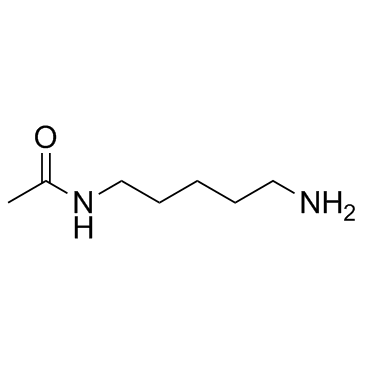
N-(5-Aminopentyl)acetamide
CAS No. 32343-73-0
N-(5-Aminopentyl)acetamide( Monoacetylcadaverine | N-Acetyl-15-pentanediamine | N-Acetylcadaverine )
Catalog No. M19992 CAS No. 32343-73-0
N-Acetylcadaverine is the acetylated form of the polyamine cadaverine. Cadaverine is produced by the breakdown of amino acids in living and dead organisms and is toxic in large doses. N-(5-Aminopentyl)acetamide is a promising biochemical marker for cancer and many other pathophysiological conditions.
Purity : >98% (HPLC)
 COA
COA
 Datasheet
Datasheet
 HNMR
HNMR
 HPLC
HPLC
 MSDS
MSDS
 Handing Instructions
Handing Instructions
| Size | Price / USD | Stock | Quantity |
| 100MG | 61 | In Stock |


|
| 200MG | Get Quote | In Stock |


|
| 500MG | Get Quote | In Stock |


|
| 1G | Get Quote | In Stock |


|
Biological Information
-
Product NameN-(5-Aminopentyl)acetamide
-
NoteResearch use only, not for human use.
-
Brief DescriptionN-Acetylcadaverine is the acetylated form of the polyamine cadaverine. Cadaverine is produced by the breakdown of amino acids in living and dead organisms and is toxic in large doses. N-(5-Aminopentyl)acetamide is a promising biochemical marker for cancer and many other pathophysiological conditions.
-
DescriptionN-Acetylcadaverine is the acetylated form of the polyamine cadaverine. Cadaverine is produced by the breakdown of amino acids in living and dead organisms and is toxic in large doses. N-(5-Aminopentyl)acetamide is a promising biochemical marker for cancer and many other pathophysiological conditions.
-
In VitroPolyamine is a small organic polycation composed of a hydrocarbon backbone with multiple amino groups which ubiquitously exists in all living organisms from bacteria to higher animals. The critical step of polyamine biosynthesis generally includes the amino acid-decarboxylating reaction to produce the primary diamines, such as cadaverine from lysine. Synthesized polyamines are implicated in a wide variety of cytoplasmic reactions such as DNA replication and protein synthesis, and are essential for proper growth and proliferation of the organisms. Cadaverine is a linear molecule that terminate at both ends with an amine functional group. These functional groups confer to the molecules multiple positive charges at physiological pH. Cadaverine is produced through the action of basic amino acid decarboxylases and is found associated with the outer membrane.
-
In Vivo——
-
SynonymsMonoacetylcadaverine | N-Acetyl-15-pentanediamine | N-Acetylcadaverine
-
PathwayOthers
-
TargetOther Targets
-
RecptorOthers
-
Research Area——
-
Indication——
Chemical Information
-
CAS Number32343-73-0
-
Formula Weight144.21
-
Molecular FormulaC7H16N2O
-
Purity>98% (HPLC)
-
SolubilityDMSO: 25 mg/mL
-
SMILESCC(=O)NCCCCCN
-
Chemical Name——
Shipping & Storage Information
-
Storage(-20℃)
-
ShippingWith Ice Pack
-
Stability≥ 2 years
Reference
1.Paik MJ et al. Urinary polyamines and N-acetylated polyamines in four patients with Alzheimer's disease as their N-ethoxycarbonyl-N-pentafluoropropionyl derivatives by gas chromatography-mass spectrometry in selected ion monitoring mode. Anal Chim Acta. 2006 Aug 18;576(1):55-60.
molnova catalog



related products
-
Fibronectin Adhesion...
Fibronectin Adhesion-promoting Peptide (Heparin Binding Peptide) is one of the heparin-binding amino acid sequences found in the carboxy-terminal heparin-binding domain of fibronectin. It promotes assembly of mesenchymal stem cell (MSC) spheroids into larger aggregates.
-
CYM50260
CYM50260 is an exquisitely agonist of sphingosine-1-phosphate 4 receptor (S1P4-R) (EC50: 45 nM).
-
Autocamtide-3 [KKALH...
Autocamtide-3 [KKALHRQETVDAL]



 Cart
Cart
 sales@molnova.com
sales@molnova.com


